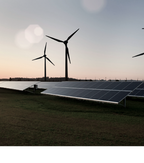artikel / 28 apr 2021
Nyheter från den nordiska energimarknaden

Setterwalls specialistgrupp inom Energi & råvaror delar med sig av de senaste marknadsnyheterna från en sektor som fortsätter att expandera i en turbulent omvärld.
Property taxation of solar PV farms – or the lack thereof
Setterwalls Tax team has successfully advised a client in obtaining an advance tax ruling confirming that the client’s large-scale solar PV farm intended for commercial production of high-voltage power cannot be assessed with a property tax value under current Swedish legislation. Provided that no appeals are filed by the Tax Agency, we expect the ruling to have general application for similar commercial PV farms, meaning in practice that large-scale PV farms should be exempt from property taxation. While we expect that the existing gap in current legislation will be rectified before the next general property tax assessment in 2025, the ruling will be welcome news for the entire Swedish solar power industry. Läs hela artikeln här.
Permits and rapid technical development
Setterwalls has successfully represented Stena Renewable in a guiding case before the Land and Environmental Court of Appeal regarding the permissibility of contemplated WTGs for a large-scale onshore wind farm. The question before the court was whether certain general statements made in the permit application documents regarding rotor size were to be considered as binding and limiting statements under the environmental permit. This has been a particularly hot topic during recent years given the rapid technological development and long processing time for environmental permits, where statements made in the past regarding contemplated turbine models may today be outdated. In its judgement from March 2021, the court held that general statements in the permit application documents regarding rotor dimension could not be considered as binding and limiting obligations under the environmental permit. The court’s decision is a welcome addition for legal certainty and promising for the wind power industry in general.
Forthcoming changes to the Swedish price area division
Sweden is since November 2011 divided into four different electricity price areas, SE1 – SE4, primarily to incentivise new establishments of power production/energy-intensive facilities where the grid conditions are favourable and to highlight bottle necks in the national transmission system. The work in adopting a new price area division stems from a pan-European initiative to evaluate the existing price area divisions in Europe. The Swedish TSO, Svenska kraftnät, has already proposed a new price area composition for Sweden comprising three different price areas in which SE1-SE2 and SE3-SE4 would be merged and a new price area, SE5 (covering only the County of Stockholm), would be introduced. The proposal from the TSO was dismissed by the Swedish Energy Agency and the responsibility for preparing a new proposal has been handed over to ACER, which is expected to issue a decision in early 2022. As a change to the existing price area division will affect existing price fixings and in particular EPAD contracts, transparency will be key in the forthcoming change process. To differentiate Stockholm as a separate price area could be an interesting move in order to tackle the local grid capacity constraints that exist and that will likely be intensified following a continued electrification in society, but it would likely come with an asymmetrical financial market with substantially lower levels of liquidity for EPAD-contracts.
New players entering the market for ancillary balancing services?
The Swedish TSO, Svenska kraftnät, is ultimately responsible for maintaining a momentary balance between energy production and consumption in order to secure the desired frequency of 50 Hz in the grid. For this purpose, the TSO can currently access five different balancing markets (FFR, FCR-D, FCR-N, aFFR and mFRR) in order to procure balancing power from providers of ancillary balancing services. Historically, operators of hydro power plants have been dominant in providing ancillary balancing services but efforts are now being made to welcome additional players in contributing with ancillary services. Provided that the thresholds for providing ancillary services are lowered and the demand for balancing power continues to increase, we would likely see inter alia wind power operators signing up for delivering balancing power by curtailing its power production when the frequency in the grid is too high.
Electrification of vehicles
The green energy transition has yet again been put into action by way of legislative amendments. In general, and effective as of March 2021, any person applying for a building permit for a new residential building or for a non-residential heated building, in both cases with more than ten parking spaces, has to construct charging stations adjacent to its parking spaces. In case of new residential buildings with more than ten parking spaces, such a requirement applies now in relation to each parking space. Furthermore, new legislative amendments apply also in some respects for existing buildings, meaning that some existing buildings will have to construct charging stations adjacent to their parking spaces by latest 1 January 2025. In addition to the practical and economic implications for developers and contractors alike, it is reasonable to expect that the market for charging stations will be booming in the near future due to increased demand from consumers and intensified electrification.
Raising the bar on the energy tax exemption for smaller power units
The Swedish government has recently proposed to raise the threshold for tax exemption for smaller solar PV units to 500 kW from the current 255 kW in installed effect. Units below the threshold are exempt from Swedish energy taxation on the power produced by the unit, as long as the power is not transferred to the power grid. Simultaneously, it is proposed to raise the corresponding thresholds for smaller wind farms and wave power plants to 250 kW in installed effect, and for other energy sources excluding generators to 100 kW in installed effect. The proposition will be up for decision in May and is expected to enter into force on 1 July 2021.
Välkommen att kontakta oss om du önskar fler nyheter om den nordiska energi- och råvarumarknaden.
Innehållet är en allmän redogörelse av informativ karaktär och är inte juridisk rådgivning att lägga till grund för bedömning i ett enskilt ärende.


